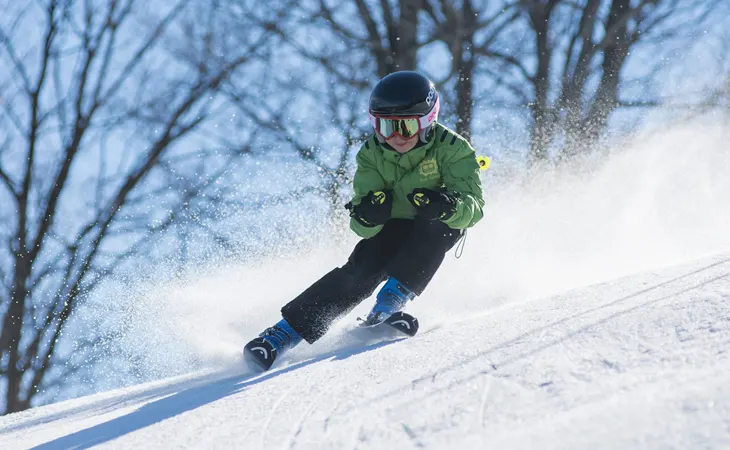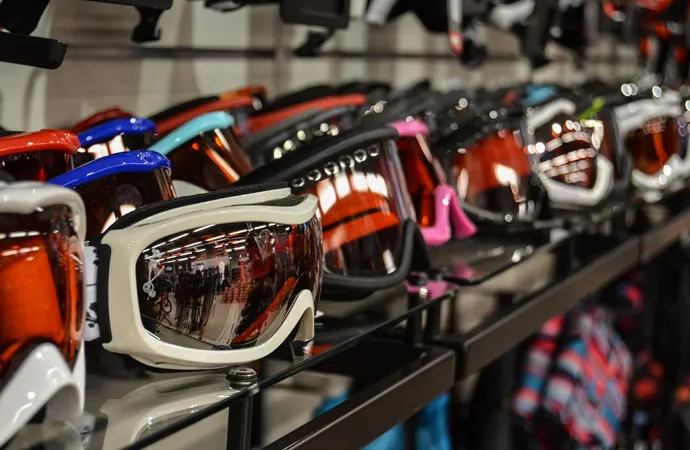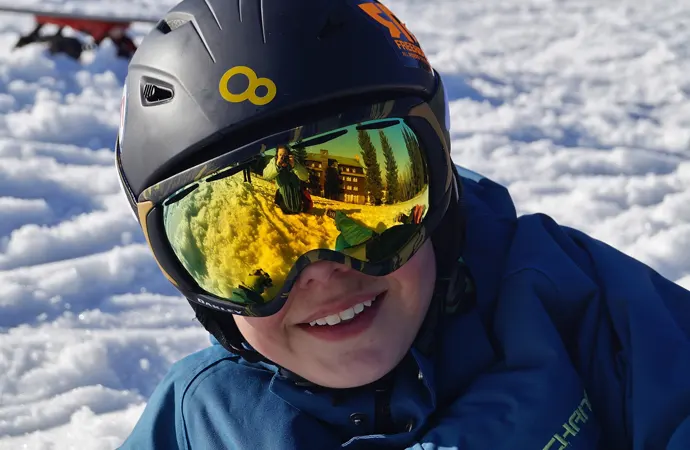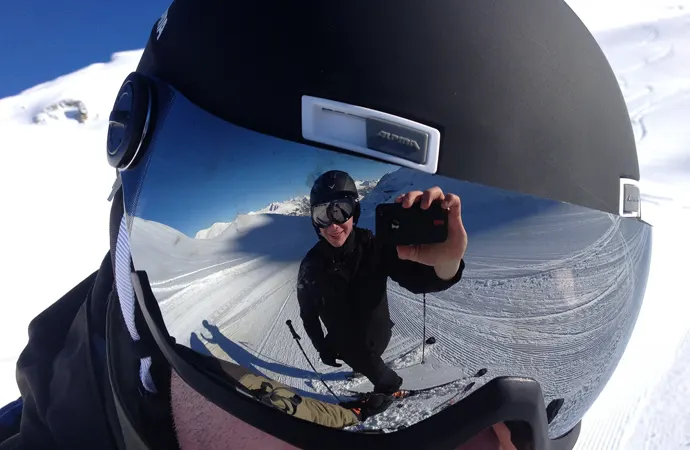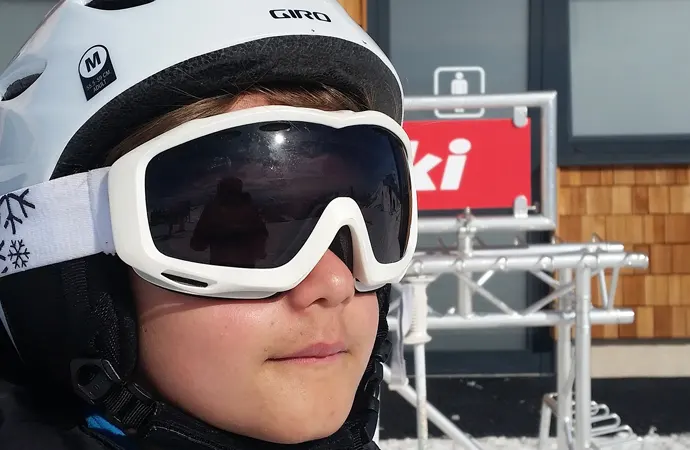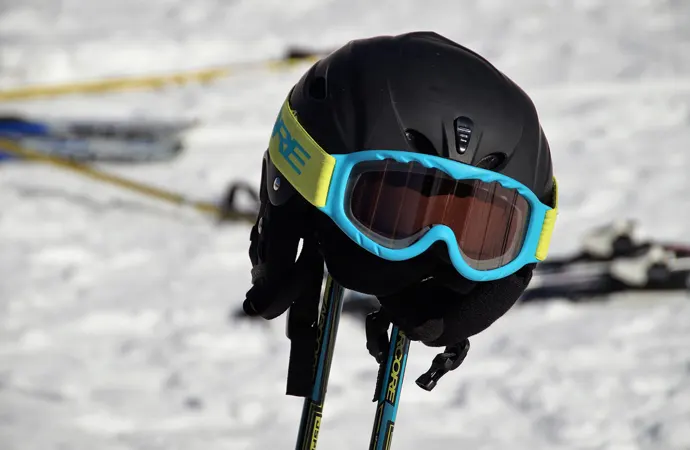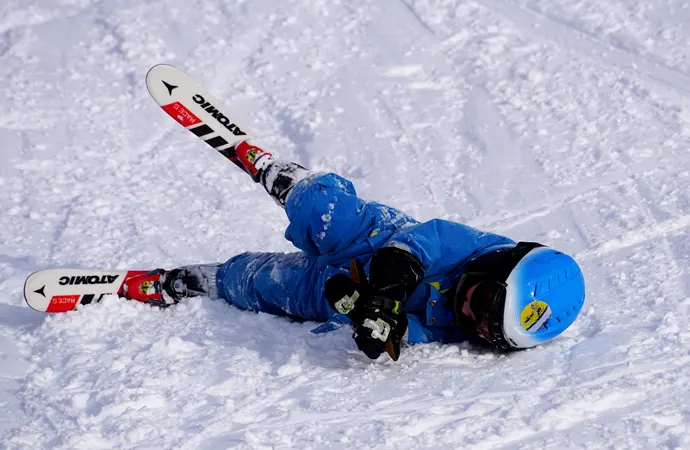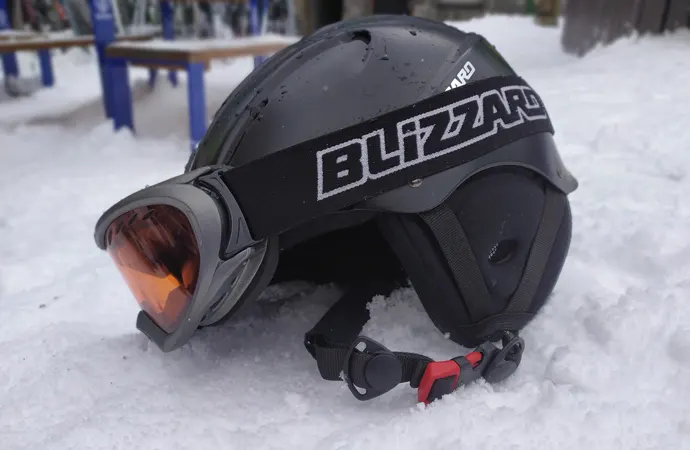Top 10 Best Kids Ski Goggles Of 2024 (UPDATED PICKS)
Ski goggles are worn to protect your eyes. It isn’t just a matter of protecting your eyes from debris that might be blown up into your face while skiing. For example, the best kids ski goggles also protect your children’s eyes from ultraviolet light and glare.
The glare may blind them at a critical moment, leading to injury, while snow blindness can cripple them for a longer time frame.
The best ski goggles for kids will protect them from all of these hazards without getting in the way of having a good time.
Are Ski Goggles a Must?
Depending on the level of expertise and preference, one can opt not to use ski goggles. Expert skiers use sunglasses instead of goggles sometimes, however, keep in mind that skiing is an extreme sport that can cause a variety of mishaps.
According to an article published on momstream.com, 9 out of 10 sports-related eye injuries are preventable by wearing the right protective eyewear. Hence, goggles are a must for better safety precautions.
What to Look for in Kids’ Snow Goggles?
1. Frame
The main functions of a goggle frame are to hold your lens in place, keep the snow out, and keep your face comfortable. While the first two main functions are easy to achieve, the third is a little tricky as people have different face shapes and sizes.
Many adults can comfortably fit into multiple sizes of goggles but for children, the size could be a concern. For young skiers, a ski goggle frame in size small has the smallest fit available.
It is narrower, shorter, and shallower than other frames and is specifically designed for smaller faces.
2. Lens
Our vision plays a critical role in ensuring safety in skiing. Because this sport is commonly played outside under various conditions where light could be too harsh or too little, we need appropriate lenses to enhance sight.
When choosing the right lens for your child, you have to consider the type, lens color and tint, Visual Light Transmission (VLT), and other features.
What are the different type of lens for ski goggles?
Cylindrical (Flat) Lenses
These lenses are curved horizontally but are flat vertically. These are relatively cheap but still deliver good performance in protecting the eyes.
Spherical Lenses
Spherical lenses are curved both horizontally and vertically around the face and give goggles a sphere-like look. These lenses have are reduced glare, less fogging, and less distortion but cost higher.
What color lens is best for snow?
Lens color and tint help skiers to have a good field of vision when there is too much or too little light available. They filter light and offer advantages in various light and weather conditions.
Lighter lens tints (yellow, gold, amber, green, rose-colored)
These lens tints are best for cloudy days when light is little and visibility is low.
Darker lens tints (brown, gray, copper-colored)
These tints are appropriate for sunny and cloudless weather normally after a night of snowfall.
Clear lenses
Clear lenses are best to use for skiing at night.
What VLT is good for ski goggles? (Visible Light Transmission)
The amount of light a goggle lens allows to pass through is called VLT. It is often expressed in percentages between 0%-100%.
Lighter lens tints
These lenses allow high VLT ranging from 60-90%. This VLT percentage allows them to perform at their best under low light and low visibility,
Darker lens tints
These lenses allow low levels of light to pass through and have a VLT of only 5%-20%. They are best for sunny days.
Some lenses have VLT measurements that are in the middle of the spectrum. If you have to stay in one place for a long time, this could be a good choice as it can adapt to the changing light conditions.
Do all ski goggles have interchangeable lenses?
Interchangeable goggle lenses are gaining popularity nowadays too.
These lenses are great for people who want to ski for a long time but don’t want to bring another pair of bulky goggles. These lenses use toggles and magnets for a quick change. These are more expensive but they usually come with an extra lens.
What is the best technology for snow goggle lens?
UV Protection
In an article by aafp.org, it was stated that skiing exposes skiers to radiation injuries caused by UV exposure. While the majority of skiing goggles sold today offer 100% UV protection for the eyes, I suggest using other UV protection products like sunscreen for added protection.
Mirrored Lenses
Whether it’s partial or full lens coating, mirrored lenses reflect more light and absorb 10% and 50% lesser light compared to non-mirrored lenses
Polarized Lenses
These lenses have a polarized filter that lessens glare from sunlight on snow.
Double Lenses
These lenses provide a thermal barrier that reduces fogging compared to single lenses. Double lenses are more common on new ski and snowboard goggles.
Anti Fog Coating
Fog can blur out the surrounding so it is good to consider an anti-fog feature in goggles. High-end goggles have built-in anti-fog coating but you can always use anti-fog products on lower-end goggles.
Photochromic Lenses
These lenses automatically adjust to changing light conditions during the day.
3. Comfort
The fit of the goggles is the best measure for comfort. In addition to that, one feature that can add comfort while wearing goggles is the vents.
Vents are important to prevent fogging that isn’t just uncomfortable but can also block your vision while skiing.
Helmets also play a role in ensuring comfort so make sure that you choose the right size of the helmet so it doesn’t block the goggle vents nor expose your forehead to possible brain freeze.
4. Fitting
A goggle fit is highly crucial as it affects the comfort and vision of the skier. Children have relatively small faces compared to adults so fitting can be a little tricky.
To make the goggle fit the face, I recommend considering the foam, straps, and helmet compatibility. Some signs that the goggle is not a right fit for your child are the following.
Goggle fit problems
- Outer eye socket pressure
- Pinching on the bridge of the nose
- A noticeable gap between the bridge of the nose and the goggle nose bridge contour that can allow debris and snow to enter the goggles.
- Pinching on the temple
These problems can easily be solved by tightening or loosening the straps. If these don’t work, I suggest trying other goggle models that fit better.
5. Layers
Layers contribute largely to preventing the interior from becoming foggy. The best number of layers to opt for is 2 or 3, which is also the same number of layers for many snow goggles nowadays.
6. Straps
For children, straps help to ensure the fit of the goggles to their faces.
A clip or a buckle are common features that allow the adjustment of the goggle. Both adjustment features are fine so it’s better to pay attention to the width of the strap. Wider straps are easier to adjust.
Some kids’ goggles are not adjustable. Hence, if you are looking for long-term goggles for your child, I recommend buying the one with adjustable straps so they can have more room to grow.
7. Foam
The foam or padding is another key feature for comfort as it prevents the goggle from pinching your face.
When examining the foam of the goggles, here are some key points to remember.
- Choose goggles with foam that follows the curvature of your face without hurting your nose and temple.
- Make sure that there are no gaps between the foam and your face.
- Opt for a goggle with thick foams enough to cushion your face but not too thick that it promotes fogging.
8. View
For view, the lenses play the most important role. The two types of lenses provide different types of view.
Cylindrical (Flat) Lenses
These lenses have lesser glare defense and may reduce peripheral vision. There are also some distortions at certain angles.
Spherical Lenses
These lenses have better glare defense and are more optically correct with minimum or lesser distortion. They also have better peripheral vision.
9. Helmet compatibility
Most goggles are helmet-compatible. However, some helmets may have compatibility issues if goggles are too large or too small. Too large goggles can come in the way of having a snug fit of the helmet and too small goggles can cause a gap and expose the forehead to brain freeze.
To choose which helmet is compatible with the goggles, I suggest putting on the helmet while trying on new goggles.
10. Over the Glass (OTG)
People with prescription glasses often have trouble participating in sports but with the help of Over the Glass (OTG) goggles, they can ski without having to remove their glasses.
These are specifically designed to fit over the eyeglasses with their extra space. Pressure on the nose and temple is also avoided with these goggles.
To use these goggles, I suggest using an anti-fog treatment on the eyeglasses to avoid any blockage of view.
Our Top 10 Best Kids Ski Goggles Review
Let’s look at some of the best ski goggles for kids.
01. OutdoorMaster Brand OTG Ski Goggles
Why It Stands Out to Us
These goggles are made for youth and smaller adults. We’ll say they’re great for teens and women. They’re called OTG or over the glasses goggles because you can wear them over your glasses.
Our Experience with It
This makes them ideal for people who wear prescription glasses. You’ll get a combination of sunglasses and protective goggles in one piece. They have a VLT or visible light transmission ratio of 8 percent.
These over the goggles glasses have anti-fog lenses. They’ll allow you to see what is going on without risking debris or fog on your prescription eye glasses.
You don’t have to deal with sunglasses, either, because the Outdoormaster goggles provide total protection from ultraviolet light. The long strap allows it to fit over any helmet.
This means you can wear it whether or not you’re wearing a helmet. The OTG goggles come with a carrying pouch. That allows you to protect them from damage when stored in your bag.
What We Didn’t Like
The foam on the goggles can absorb moisture. This creates problems when you’re sweating heavily or it is snowing. They’ll absorb the moisture then release it into the goggles.
This means that the anti-fog goggles can fog up in certain conditions. This can also cause the goggles to take on a mildew smell.
HIGHLIGHTED FEATURES
- Over-the-Glasses (OTG) design that fits over glasses
- The size fits kids, teens, and adults
- Dual layer lens technology that delivers excellent optical clarity
- Anti-fog inner lens
- Effective and reliable UV protection
- Soft TPU frame for added protection against impacts
- Long and elastic strap that ensures great compatibility with all helmets
02. ZIONOR Brand Lagopus Ski Snowboard Goggles
Why It Stands Out to Us
These polycarbonate ski goggles by Zionor provide excellent protection for your eyes. They’re solid, they’re durable, and they’re scratch resistant.
Our Experience with It
The VLT for these ski goggles is 11 to 18 percent depending on the weather conditions. This makes them a good choice for those who want their ski goggles to double as sunglasses.
They don’t just resist fogging. They have good ventilation so that sweat won’t cause them to fog up.
That won’t prevent moisture from penetrating the seal when it is snowing, but that prevents the goggles from mildewing.
The manufacturer says they are over-the-helmet and over-the-glasses. They have a long strap that allows them to fit over helmets and head-gear. However, the strap is too long and loose to fit children. It will work for your teenager.
What We Didn’t Like
The scratch resistance is only on the outside of the lenses. You can scratch them while cleaning the inside if you aren’t careful. This can cause problems if your prescription glasses rub against the goggles.
If moisture collects inside of the goggles, you can’t remove it without taking off the goggles. The plastic used has a strong chemical smell immediately after you open the packaging.
HIGHLIGHTED FEATURES
- Solid and durable anti-scratch lens to keep the goggles looking new
- Smart ventilation system
- Anti-fog lenses
- 100% UV Protection treatment on double-layer lens
- Long and durable strap that allows users to wear a helmet over their goggles
- Anti-wind functionality
- OTG designed allowing to fit small to medium size glasses
- Design to fit both men and women
- Suitable for kids, young people, and adult
03. Cooloo Brand All-Purpose Goggles
Why It Stands Out to Us
Cooloo says these goggles can be worn whether you’re skiing or riding on a motorcycle. They also say these goggles can be worn by men, women, and children. But are they truly universal, all-purpose goggles?
Our Experience with It
These goggles have a narrow frame. They can be worn by older children, teens and smaller women.
They will not fit adult men. But they have a snug fit for smaller users, assuming you aren’t wearing them over a helmet or glasses.
The padding is thin, so it may be uncomfortable to wear for a long period of time. They’re basic wrap-around goggles. They’ll keep the wind, snow and dust out of your eyes.
They have an anti-glare coating that’s useful when you’re skiing or snowboarding or riding in a side car of a motorcycle. This makes them one of best ski goggles kids could have, if you want something they can use almost anywhere.
You get a carrying bag as well as the goggles when you buy this brand. Not every pair of kids snow goggles comes with one of those.
The visible light transmission or VLT is roughly 10 percent. They’re better for bright sunny days and when you’re dealing with a lot of light reflected off the snow.
What We Didn’t Like
The lenses on these goggles are very thin. Do not wear them for the impact protection, because it can’t do more than prevent dust and snow from getting in your eyes.
It will not protect your eyes from a pebble or piece of wood hitting your face. This means you should not wear them when snowboarding.
These goggles are not anti-fog. You can wear them when working outside in the snow, but they will not prevent fogging when you’re on the ski slope. It is hard to clean these goggles.
It may take repeated passes to get smudges off. This makes them a poor choice for snowboarders and those who periodically run into bushes and trees.
HIGHLIGHTED FEATURES
- Compatible with youth and adults of any gender
- Long elastic straps to ensure helmet compatibility
- Anti-fog coated lenses
- Maximum airflow in the goggles through circular holes that also help prevent fog
- Tinted lenses that provide UV400 protection
- Flexible ABS frame for extra safety
- Durable and impact-resistant PC lenses that effectively block sunlight, strong winds, and heavy snow
- Comes with a layer of lightweight and thick sponge for warmth
- Can be used for different activities like mountaineering, riding motorcycles, construction site visits, and more
04. ZIONOR Brand X Goggles with Reflective Spherical Lenses
Why It Stands Out to Us
These goggles are unusual for having a large pair of reflective spherical lenses. This is intended to maximize visibility for the wearer, since you don’t have a black line down the middle as you see in standard goggles.
Others choose it because it looks cool. For some, that’s reason enough to say they’re the best ski goggles for kids, since your children want to wear it.
Our Experience with It
These over-the-glasses goggles can be worn over your sunglasses or prescription glasses. They offer UV protection,
but you may want to wear them over sunglasses if you’re in very bright conditions. They have a generally good fit on your face, whether or not you wear glasses.
However, the straps don’t work well when you want to wear them over a helmet. These goggles have UV 400 protection. This protects you from ultraviolet light and the risk of snow blindness.
What We Didn’t Like
They don’t do a good job of keeping the moisture out. This can cause fogging, especially along the top of the glasses. The padding won’t keep out the cold, so the moisture may even freeze next to your face.
The mirror finish is attractive. However, it doesn’t last. It fades over time, especially with exposure to sunlight. These goggles are not very impact resistant.
Do not wear them if you’re doing acrobatics or could get a face full of tree leaves. They will scratch up.
HIGHLIGHTED FEATURES
- Panoramic designed ski goggles that provide a clear view
- Anti-fog lenses
- Provides great protection against harmful UV rays
- OTG snow goggles that can fit over glasses that are 5.51 inches in length and 1.57 inches in height
- Ruggedized lens with ZIONOR special EDT (Enhanced Durable Tech) that is guaranteed to provide better impact and shock resistance
- Curved and optimized frame that is compatible with many helmets
05. AKASO Brand Kids Ski Goggles
Why It Stands Out to Us
These are some of the best kids ski goggles on the market. They’re made to fit your child’s face and head. This results in a tight fit, as long as your child is in the right age range.
They’re perfect for 5 to 12 year old skiers. Yet your kids get the same spherical lenses found on many adult ski goggles, a trait that improves their peripheral view.
Our Experience with It
They resist fogging and block ultra violet light. They’re reported to have 100 percent UV 400 protection. Too many rival products either act like sunglasses or resist fogging but can’t seem to do both.
The anti-fogging is due to their tight design barring carefully located vents. These ski goggles for kids have a VLT of 10 percent.
They’re helmet compatible. They’ll fit over almost every style of kids’ ski helmet. They are more secure than average thanks to anti-slip silicone backed strap.
What We Didn’t Like
While they blog ultraviolet light, they do not act like sunglasses. This can cause problems if there is a lot of glare. You need something with a higher VLT rating if you want to avoid squinting or needing additional sunglasses.
On the other hand, the best kids ski goggles night will have a VLT rating near 100. The strap isn’t durable. And the problem is worse when it is very cold. If the goggles freeze, the strap loses its elasticity. Then it is prone to breaking.
HIGHLIGHTED FEATURES
- Spherical lens that allows clear peripheral vision
- Distortion-free view
- Mirror coating that removes glare
- Lens that are made with material that offers 100% UV 400 protection
- Features double-layer lens design and high-performance hydrophilic coating to avoid moisture buildup and fogging
- Venting windows at the top and bottom for efficient air circulation
- Helmet-compatible and anti-slip silicone backed strap
- Triple layer foam for more protection and comfort
- Strong and flexible TPU frame
- Anti-scratch and impact-resistant lens
- Can fit 3 years old to early teenagers
06. Rngeo Brand Ski Goggles
Why It Stands Out to Us
These Rngeo brand ski goggles are sold as a set. This makes them a better than average deal, such as when your kids often lose their goggles or you want to buy a matching set of ski goggles for your children.
Note that while the manufacturer says these goggles can be worn by 3 to 13 year old children, it won’t fit kids 7 and under.
We’d recommend them for kids 9 and up. And while the manufacturer says they can be worn by adults, it is too small for them, unless you’re unusually small.
Our Experience with It
They need to be the right size for your face, if you want it to keep the wind from irritating your eyes. Aside from two for the price of one more expensive brand’s snow goggles?
They’re kid-sized, and that’s hard to find. They aren’t high end, but that doesn’t matter much given the price. For example, they’re basic eye protection from snow and dust.
Because they’re rainbow colored, they’re gender neutral. Both your son and your daughter could wear them. And you’re getting two of them.
These are arguably the best cheap ski goggles for kids. They have the standard UV 400 protection and anti-glare protection.
What We Didn’t Like
They fog up. That makes them a poor choice for skiing at high speeds, though it is OK for kids just playing in the snow. The bands are not well-attached to the goggles. They may come undone or outright break. Don’t try to stretch them over a helmet.
HIGHLIGHTED FEATURES
- Comes in many vivid color variations
- Features air vents on top of the frame that allows good air circulation
- Adjustable and detachable elastic head strap for convenient safekeeping
- Provides UV400 protection
- Has anti-glare function for improved vision and lesser eye strain
- Allows the user to have a wide view angle
- Suitable for other sports and activities like shooting games, skating, and more
- Safe and flexible ABS frame
- Strong and impact-resistant PC lens
- Thick and soft foam on the frame that gives the user comfort around the eyes
07. Elimoons Brand Ski Goggles,
Why It Stands Out to Us
This is another set of kids ski goggles. They have the same semi-spherical lenses that you’d find in adult ski goggles, something that improves their peripheral vision.
They’re the best kids ski goggles for preschoolers, since they’re some of the few ski goggles that will fit 2 to 6 year old children.
Our Experience with It
These kids ski goggles are wind and glare resistant. They’re also UV 400 resistant. This makes them purely functional. For example, they have thin foam, so they’re not very comfortable if you’re wearing them all day, but it is better than nothing.
Note that they’re not suitable for wearing over eye glasses or a helmet, but then again, they aren’t advertised as such.
What We Didn’t Like
They’re prone to fogging up. There are ventilation holes, but they’re not very good. The frame can also be wide on someone’s face, leaving minor gaps that let in moisture and cold air.
This doesn’t prevent fogging, either, if it happens. The frame isn’t very durable. They may break. The lenses may even shift in the frame. Then they could fall out.
The lens is one piece, so if it breaks or falls out, you’ve lost the entire thing. The lenses themselves are thin, though there aren’t complaints of those breaking.
HIGHLIGHTED FEATURES
- Perfect for youth girls and boys
- Effectively protects against wind, dust, cold air, and snow
- Can be used for other outdoor activities like mountain biking, skydiving, and more
- Multicolor lenses that protect the eyes from damage due to sunlight
- Durable and elastic TPU frame to fit snugly against the face
- Impact-resistant PC lens
- Thick and soft layer of sponge to avoid pain and irritation due to prolonged wear
08. OutdoorMaster Brand Kids Ski Goggles, Helmet Compatible
Why It Stands Out to Us
These mirrored ski goggles by Outdoormaster have a VLT of 10 percent. They are intended for children six years old and older. We’ll say they’ll fit someone up into their teens, though they are too small for most adults.
Our Experience with It
These goggles are helmet compatible. They fit over many prescription glasses but that is not guaranteed. They provide complete protection from UV400. That’s standard for this product class.
These kids ski goggles offer advanced eye protection. They have a soft frame that provides greater protection to the face if the glasses are impacted.
This is in contrast to other ski goggles that are prone to breaking and may create more problems if someone is in a crash. They’re one of the best big kids ski goggles.
You get a carrying bag along with the ski goggles for kids.
What We Didn’t Like
The fog-resistant coating inside of the goggles is too delicate. You could damage it if you clean the inside of the lenses too hard or if it gets scratched. A different problem is the relative lack of ventilation in the goggles.
They can fog up due to sweat and condensation, because of poor ventilation. The combination of these two factors means you can create problems trying to clear the goggles.
HIGHLIGHTED FEATURES
- Compatible with any ski helmets
- Suitable for boys and girls 6 years and older
- Various colorful lenses and frame options
- Provides 100% UV protection
- Provides effective eye protection against snow, wind, and more
- Soft frame to ensure a good fit and have extra safety when crash or falls occur
- OTG design that allows users to wear glasses under the goggles
09. Bolle Schuss Brand Black Chrome and Matte Black Goggles
Why It Stands Out to Us
These goggles are described as safety glasses. They’re advertised as fitting adults, but in reality, they fit older children. This means you can get adult quality ski goggles that fit a 10 to 16 year old.
Our Experience with It
The Bolle Schuss ski goggles have an average anti-fog coating. Like other ski goggles on this list, the anti-fog coating is easily scratched.
At least the vents on the goggles do a better than average job of venting excess moisture. The padding is about as thick as average. It is comfortable to wear for hours.
However, they cannot absorb significant impacts. Don’t wear them if you’re going snowboarding or doing anything acrobatic. They are not a replacement for sunglasses.
They offer only basic protection from ultraviolet light. You get a carrying bag with them to help protect them when they’re in storage.
What We Didn’t Like
They are described as having purple lenses. In reality, they have a light blue tint. This may affect your vision, if you wanted a darker shade.
The lenses are not as reflective as described, either. This causes frustration for those who expected mirrored shades.
HIGHLIGHTED FEATURES
- Anti-fog feature with Phantom and Phantom lenses
- Features an anti-fog layer in the inner lens to prevent moisture formation
- High-tech protective armor on the outer lens that is resistant to scratches
- Offers 100% UVA/UVB protection
- Flow tech venting feature that helps in reducing fog buildup and improving airflow
- Strong double lens design that protects and gives warmth to the user
10. Bolle Brand MOJO Shiny Black/Clear Goggles
Why It Stands Out to Us
These Bolle snow goggles have a classic design. You get a black frame and clear protective goggles. They form a protective seal over your eyes, protecting them from wind and wind-blown debris.
Our Experience with It
These are not the best ski goggles for kids, because they are intended for adults. Officially, they’re medium-to-large, but they are smaller than you’d expect large goggles to be.
In reality, they will fit your teenager or a smaller adult. These goggles can fit over most helmets. They’ll typically fit over a small or medium sized helmet.
These goggles have excellent ventilation and a good anti-fog coating. They won’t fog up. And they won’t collect ice and snow.
If there is sweat trapped inside the snow goggles, it is unlikely to freeze. They’re unusual for resisting scratches.
What We Didn’t Like
The foam is thin. The goggles’ shape is somewhat awkward. This can result in it fitting poorly on your face or being uncomfortable.
These goggles are not designed to be worn over sunglasses or prescription eyeglasses. In fact, they’re too narrow to be worn over glasses.
HIGHLIGHTED FEATURES
- P 80+ anti-fog treatment that prevents the formation of moisture and provides a clear view for the user
- Carbo GLAS anti-scratch treatment to keep the goggles looking new
- Features a high-tech protective armor applied to the outer lens that provides extra protection against damages and lessens scratching
- Offers 100% UVA/UVB protection
FAQs Regarding Kids Ski Goggles
Question: How do the best kids ski goggles work?
Answer: The best ski goggles will protect against the sun, the snow and everything else. Whether you want them to fit over a helmet or not is a matter of personal preference.
Whether they minimize glare or maximize visibility in low light conditions depends on when you’re sending them out to go skiing.
Most ski goggles are held in place by an elastic band, since swaying and swooping on the slopes can cause regular sunglasses to fall off.
Do not put adult ski goggles on a child, since it will not stay securely in place and may even interfere with their vision. That’s why the best kids ski goggles are designed just for kids.
Question: What Age are Junior Ski Goggles for?
Answer: Junior ski goggles are suitable for 8-16-year-olds. However, age is not the sole basis for choosing goggles as fit and comfort are more important factors.
Question: Do Beginner Skiers Need Goggles?
Answer: Yes. While you can rent other ski equipment like skis and boots, you have to buy your personal ski essentials like pants, helmets, gloves, and hand warmers.
Question: What Should a Beginner Skier Wear?
Answer: As beginners, there is no need to buy expensive and first-rated ski clothes. Instead, beginners can wear warm clothes like a turtleneck, sweater, fleece jacket, or insulating pants. Denim is not advisable in skiing.
On the outside, wear a winter jacket and waterproof snow pants. You should also wear pair of winter gloves. helmet and hand warmers.
Question: How much should you pay for ski goggles?
Answer: Ski goggles are now considered a buyers market. This means that the products and buyers are many so they are sold at a low price.
As we know. quality comes at a price, so expect that cheap goggles aren’t as effective as expensive ones.
Nevertheless, you can buy functional goggles for as low as $75. If you are considering skiing as a long-term hobby you can spend as much as $200 – $250 for the high-end goggles.
Question: Should you wear ski goggles at night?
Answer: Yes. Ski goggles provide optimum protection for the eyes no matter what time of the day it is.
They protect the eyes from snow, debris, wind, insects, and ice that can harm or impair your eyes. In addition to protection, goggles help you to have a better vision while skiing.
Question: Do ski goggles keep your eyes warm?
Answer: Yes. Ski goggles not only protect the eyes but also keep the eyes warm and prevent frostbite.
Question: Why do skiers often wear sunglasses while they are skiing?
Answer: While goggles are a lot safer for all-weather and light conditions, expert skiers wear sunglasses on warmer and clear days. Sunglasses offer a more lightweight and comfortable feeling and the polarized lenses of the sunglasses protect the eyes from the light reflections on the snow.
For beginners and children, it is still best to wear ski goggles.
Final Verdict
The best kids ski goggles will fit their face and protect their eyes in the conditions in which they’ll be playing. The right ski goggles for your children will depend on their size, the climate in your area and the features you choose to prioritize.
Do you want to protect their eyes from ultraviolet light or ensure that their vision is protected if they run into a tree branch? Answers to questions like this will determine which of the ski goggles on our list is right for you.

